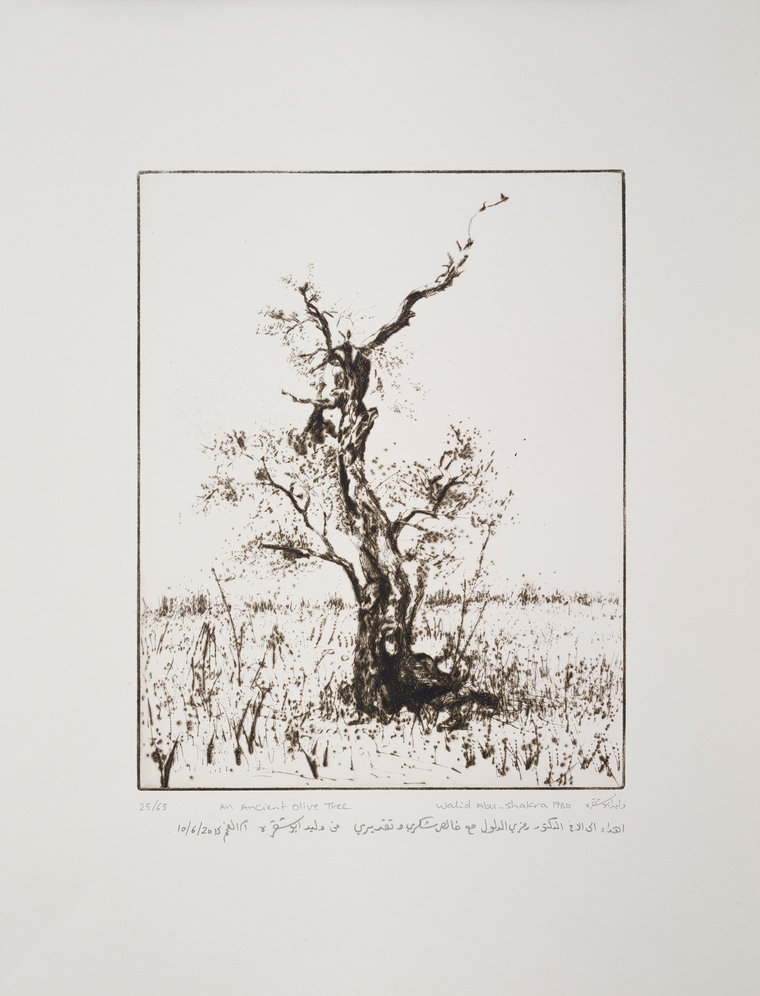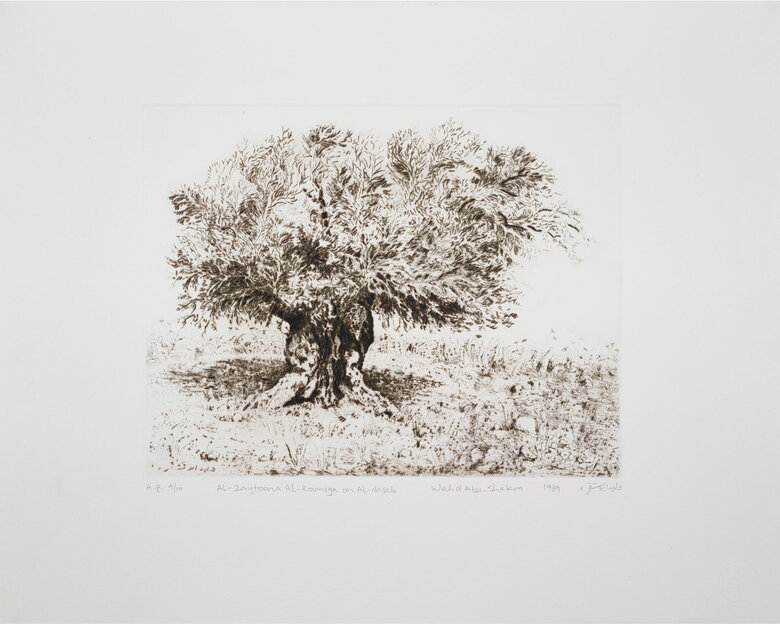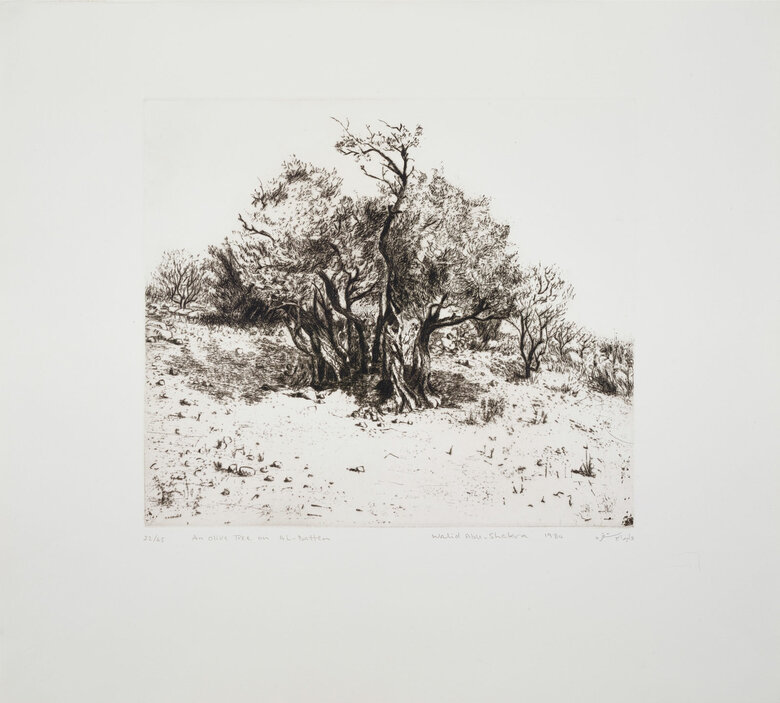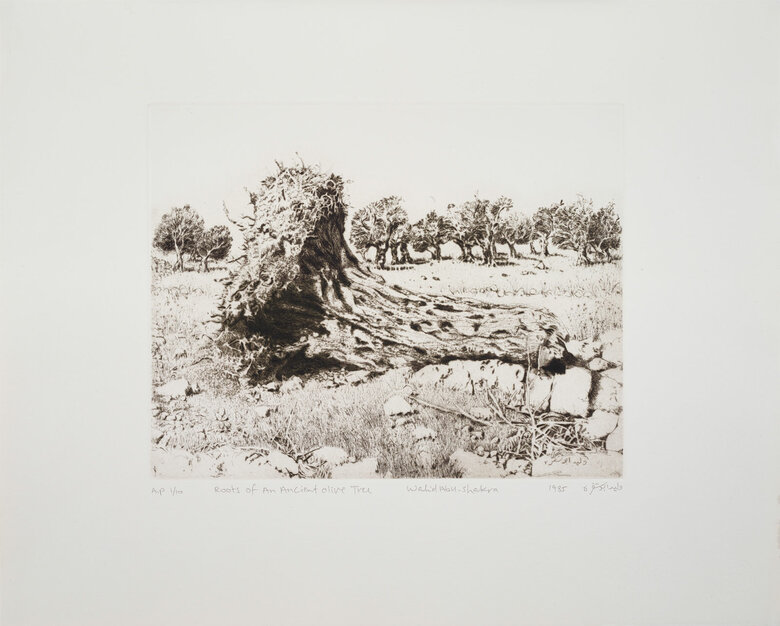Abu Shakra's art profoundly explores Palestinian identity, blending artistic expression with cultural preservation. Through a meticulous selection of printmaking techniques – drypoint engraving, aquatint, and etching – Abu Shakra captures the essence of the Palestinian landscape, imbuing each work with layers of emotional and symbolic meaning. His prints do more than depict the physical environment; they document the resilience of a people whose connection to the land is profoundly historical and fiercely contemporary.
In the displayed prints, Abu Shakra employed several printmaking techniques – aquatint, drypoint engraving, and etching on paper – each carefully selected for its unique capacity to convey different emotional and symbolic elements of the Palestinian landscape. Aquatint, for instance, involves dusting powdered rosin (a kind of resin) onto a metal plate, which is then heated to fuse the particles that will catch onto it. Subsequently, the plate is submerged in acid, producing a range of tonal effects depending on the length of exposure. On the other hand, drypoint engraving is executed by scratching the metal plate with a sharp needle, which creates a burr that results in rich, textured lines when inked and printed. Finally, etching involves coating a metal plate with a waxy, acid-resistant ground; after drawing the desired figure into the ground, the plate is etched in acid. This process allows for the creation of highly detailed and precise imagery.
In Field on Al-Battin with Cactus and Olive Tree, 1982, Abu Shakra uses drypoint engraving to create a landscape that is both a literal and metaphorical representation of Palestinian identity. The olive tree is a central motif, symbolizing peace and resilience. The cactus, or sabr (also meaning patience in Arabic), embodies the resilience of the Palestinian people, reflecting their enduring connection to the land. This piece is not just a depiction of nature but a subtle act of resistance, as the cactus historically marked territorial boundaries for Palestinian farmers – a quiet assertion of ownership and identity in the face of dispossession.
Acre, 1976 was created using the aquatint technique, exploring the land's deep cultural and historical significance. The name Acre refers to a city in Palestine, while also being a term derived from Latin, referring to the amount of land that could be plowed in a day – a concept deeply connected to the agricultural heritage of Palestine. Through aquatint, Abu Shakra evokes a sense of continuity and stability in these works, highlighting the fields not merely as agricultural spaces but as symbols of the Palestinian people's ongoing relationship with their land. The subtle gradations of tone in aquatint allow for a nuanced portrayal of these landscapes, emphasizing the importance of land as both sustenance and identity in Palestinian life.
In An Ancient Olive Tree, 1980, Abu Shakra uses etching to revisit the olive tree motif. The olive tree in this print stands as a metaphor for the resilience and continuity of the Palestinian people. Abu Shakra meticulously depicts the tree's intricate textures through etching, emphasizing its age and strength. This work transcends its literal subject, becoming a symbol of the deep-rooted connection between the Palestinian people and their land, an unbreakable bond despite the challenges of displacement and occupation. The olive tree, enduring and ancient, reflects the steadfastness of the Palestinian spirit, rooted deeply in the soil of their homeland.
Abu Shakra's choice of printmaking was a deliberate and powerful means of preserving and resisting the erasure of Palestinian cultural and geographical identity. Through his art, Abu Shakra created a lasting record of the Palestinian landscape and its symbols, offering a visual narrative that underscores the resilience and enduring connection of the Palestinian people to their land.
Edition number, title, artist name in English and Arabic, date of production and dedication to Dr. Ramzi Dalloul on the lower front



-WalidAbuShakra-Front.jpg)
-WalidAbuShakra-Front.jpg)








-WalidAbuShakra-Front-(1).jpg)
-WalidAbuShakra-Front-(1).jpg)

